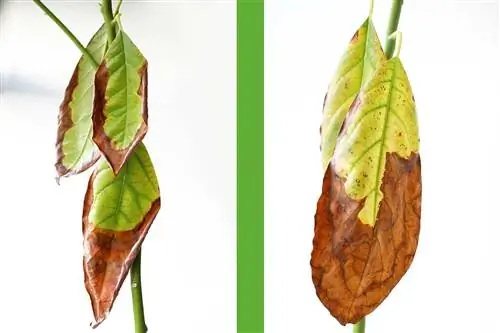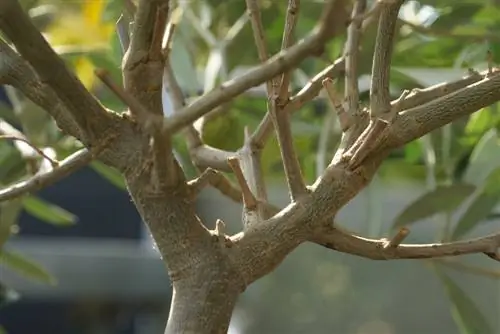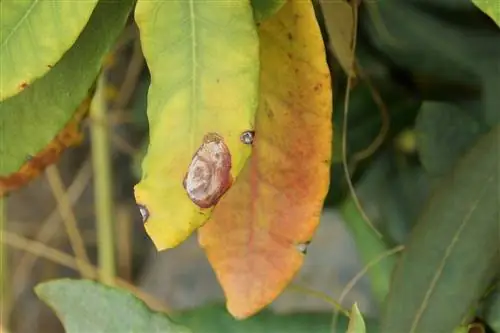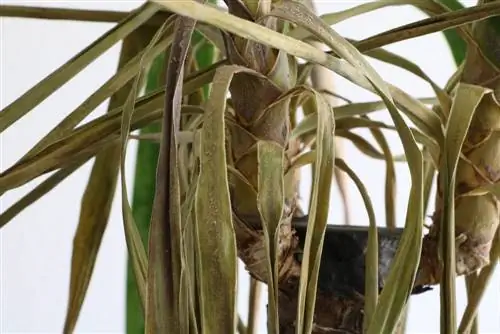- Author admin [email protected].
- Public 2023-12-17 03:39.
- Last modified 2025-01-24 12:45.
Cultivating an avocado plant is generally not difficult. However, mistakes in care, diseases or pests can cause the leaves to discolor. But what are the exact causes?
Inconvenient location
Brown discoloration on the leaves in most cases indicates care errors, which can also be the cause of diseases. Major mistakes can be made when choosing the right location. For example, if the avocado is in the blazing midday sun, brown discoloration usually indicates sunburn. Nevertheless, it should be bright. With the right location, such leaf discoloration can be avoided.
Remedy
- place the relevant copy in a more suitable place
- on a sunny windowsill
- Young plants slowly get used to the sun
- Place with 12 hours of light daily
- in summer, outdoor location possible
- bright locations and moderately warm temperatures all year round
- at least 23 degrees during the day, 15 degrees at night
- not below ten degrees
Tip:
In contrast to younger plants, old specimens also cope well with direct midday sun.
Wrong substrate
The wrong substrate can also cause the avocado plant to dry out and turn brown. The classic potting soil from the hardware store is less suitable in this case, as are substrates that are too dense. They do not correspond to the soil conditions in the natural locations. For example, a pH value that is too high can make it difficult for iron and zinc to be absorbed and thus inhibit growth. Follow.
Remedy
- Use low pH substrates
- more acidic than alkaline
- ideally between five and seven
- Reduce soil pH that is too high
- for example with coffee grounds or needle soil
- loose, permeable, sandy, not too s alty soils are ideal
- such as special substrates for palm and citrus plants
Tightness in the pot
Another cause of brown leaves can be a pot that is too small and restricts the roots. As a deep-rooted avocado, it needs a pot that is deep rather than wide. Since the roots grow downwards, especially in the first few years, they quickly reach the ground in a wide pot and can no longer develop any further. This also affects the above-ground parts of the plant. The leaves brown, dry up and fall off.
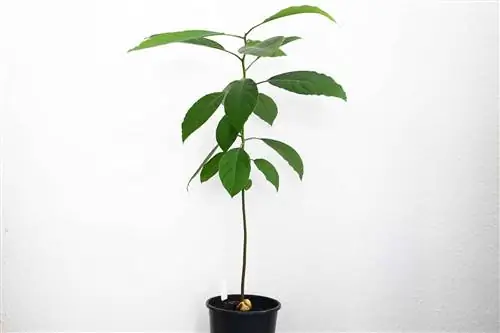
Remedy
- repot the affected avocado immediately
- new pot about 20 percent larger than the old one
- Don’t forget drainage on the bottom of the pot
- generally move young plants annually
- older every two to three years
- best time to repot in spring
- prune when repotting
- remove excess shoots
Too much fertilizer
Another common problem is over-fertilization. It leads to corresponding leaf damage and can cause lasting damage to the avocado plant. Young specimens in particular are often fertilized too much, even though they are relatively frugal in this regard, especially in the first few months. Here less is more.
Remedy
- Repot the avocado immediately into fresh soil
- take out of the pot, remove all old soil
- place in a clean pot with suitable substrate
- do not fertilize in the following weeks
- fertilize sparingly every four to six weeks in the future
- with citrus, green plants, potted plants or universal fertilizer
Tip:
A home-grown avocado should not be fertilized in the first six months after sprouting from the pit. During this time, the plant supplies itself entirely from the core.
Watering error
Both too much moisture and lack of water lead to damage to the leaf. Prolonged wetness is usually reflected in completely browning leaves and a lack of water in brown leaf tips. Lack of water can usually be easily remedied. Things are different if the roots are already starting to rot, then you need to act quickly.
Remedy
- If there is a lack of water, adjust the watering quantity and frequency
- Do not place plants near the heater
- repot immediately if root rot occurs
- remove old soil and rotten root parts completely
- Clean the pot thoroughly or use a new one
- Planting avocado in fresh substrate
- don’t water at first
- water later only moderately
- Remove excess water in coasters promptly
Too low humidity
To stay on the topic of humidity, too low humidity can also turn the leaves brown or be responsible for brown leaf tips. Due to its origin, this plant requires sufficient humidity. This is, among other things, important to prevent pest and disease infestation. To increase it accordingly, it is usually sufficient to spray the plants with lukewarm water every now and then. In addition, it may be advisable to occasionally remove dust from the leaves with a damp cloth.
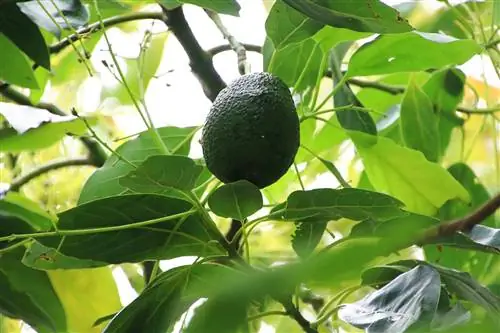
Illnesses as a cause
Brown, black or yellow spots on the leaves can be an indication of anthracnose disease. It is caused by a fungus and primarily affects very young and already weakened plants. Affected foliage should be cut off and the plants treated with a suitable fungicide.
Pests
When it comes to pests, mites in particular should be mentioned. They cause brown discoloration and deformities on leaves, flowers and shoots. The young leaves are primarily affected. Older ones show brown spots or corking, especially on the undersides of the leaves. To combat it, specialist retailers offer systemic acarcides, which must be approved for houseplants. If the avocado is grown as a crop, such products are not suitable. As a preventative measure, too much moisture and significantly too high humidity should be avoided.

